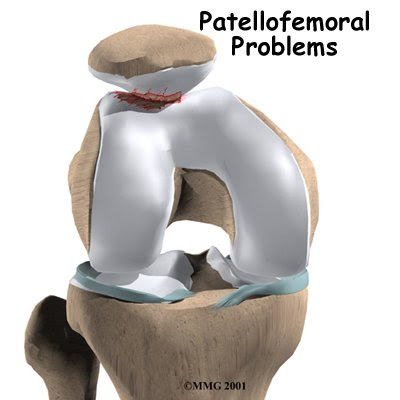
The quadriceps femoris via common tendinous (quadriceps tendon) & independent attachments to base of patella; indirectly via patellar ligament to tibial tuberosity. Get it right or ouch! In fact have poor skills and ouch! The articular muscle of the knee is greatly over looked with the KOPS! Muscles only pull, and they can be pulled too much.
The articular muscle of the knee (L. articularis genus), a small, flat muscle, a derivative of the vastus imtermedius attaches superiorly to the inferior part of the anterior aspect of the femur & inferiorly to the synovial membrane of the knee joint & the wall of the suprapatellar bursa.
The articular muscle pulls the synovial membrane during extension of the leg, preventing folds or being compressed between the femur & patella w/in the knee joint. If your saddle it too low, too far forward, you place too much tension on it and it can be pulled (micro tears).
As for the patella (knee cap), it is a large sesamoid bone, formed intratendinously after birth, located anterior to the knee joint. You can have a number of different types i.e. Type I, Type II, Type III, etc... It articulates with the femur. The anterior surface of the patella is convex; the thick base (superior border) slopes inferoanteriorly; the 2 lateral & medail borders converge inferiorly to form the pointed apex, and the articular surface of the knee cap is smooth, oval area divided into articular facets by a vertical ridge. They are not all the same!!!


Did they use the KOPS on him? We know that method can harm your knees, yet it is used?
WN - the smallest of changes can take you out! "Compression, shearing and tension" really makes a difference. Why take a guess when you can obtain your best solution?
- Pain in his left knee forced Taylor Phinney (BMC) to abandon his first WorldTour race.
Reports point out that Phinney said he first felt the pain on stage 1. On the 3rd stage, he hung with the peloton over the first two climbs. But by the third climb, his knee was done, he said. “One of the hardest things to do in the sport of cycling is to get off your bike and I fought as hard as I could. I am incredibly disappointed!
Your career in any sport is short lived, yet another setback in his first year as a professional.
BMC chief medical officer Dr. Max Testa said the pain in Phinney’s quadricep tendon was likely due to several factors: small changes in his position a few days before the race, cold weather on the race’s opening day, and the intensity difference between training and racing.
We will never know! Who ever performed the fit will never point to one thing, but if they used the used the KOPS, that is the most likely issue. Too low a saddle can hurt you!
Want to know more? Do your homework and you be the judge!
If you aren't in the game, your out! Below is true story about a guy who was in great pain before, then he used our fit.
tom
you fitted me in boise in late june/early july of this past year. i was the guy with the blue felt doing the oregon to new hampshire abb group ride the rest of the ride went great i rode trouble-free, more at ease on the bike (and off the bike afterwards), and faster the rest of the way "levitating" the remaining 2,500 miles.
i sold the bike when i got home but transferred the measurements to an older kestrel that is just more fun to ride
anyway i'm thinking of buying a new road bike i currently have 172.5 cranks but would like to do things right
would you recommend a crankarm length based on my measurements?
thanks again for the great fit and a memorable conversation
mark scheer






No comments:
Post a Comment